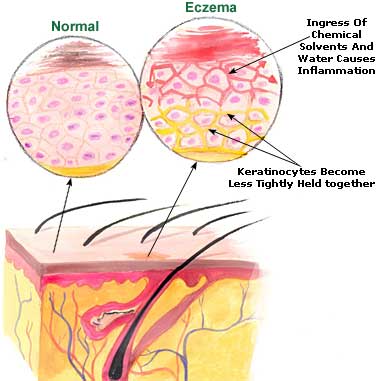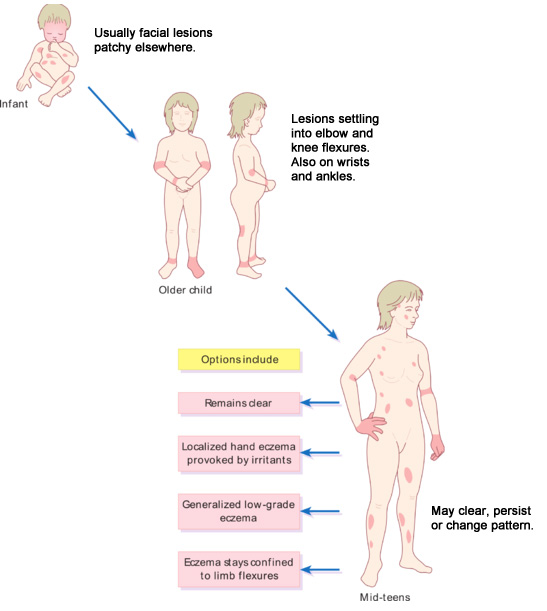
Eczema is dry patches of red itchy skin. Scratching damages the skin and can make the rash worse.
Eczema can also be called atopic dermatitis. It is common to appear in early life, usually before age 1. Patches will develop on a child’s face, forehead and scalp. Atopic dermatitis is very itchy.
Scratching can worsen atopic dermatitis and even cause secondary skin infections. Atopic dermatitis is a chronic disease, so it is important to learn how to treat and control this common rash.
What Causes Eczema?
No one knows for sure. We do know that it is not contagious. It is more common in children who have family members with atopic dermatitis, asthma or allergies. Other contributing factors are environmental – cold, dry climates are more likely to cause problems in children with eczema.
What Does Eczema Look Like?
In Infants

- Rash that appears suddenly and makes the skin dry and itchy
- Rash on the scalp and face
- Rubbing against bedding and carpeting to scratch
- Trouble sleeping
- Rare in diaper area
In Children

- Rash that begins in creases of elbows or knees
- Itchy, scaly patches where rash was
- Skin can get bumpy
- Skin can lighten or darken where rash was
- Persistent itch

Diagnosing Eczema
Most of the time, diagnosis is through visual inspection of the skin. Questions will also be asked.
Sometimes, patch tests are performed to look for contact allergies. Patches are placed on the skin and re-checked in 96 hours.
Allergy testing for seasonal allergies can also be performed. This will be done either by RAST or skin testing, depending on the patient.
Treating Eczema
Treatment includes medications, skin care products and lifestyle changes. It is important to prevent flare ups.
Instructions For Daily Skin Care
- Oral antihistamines to minimize itching are mandatory. Itching and scratching will aggravate this condition. Non-sedating antihistamines will be sued first and if they do not control the itching, one of the older, sedating products such as Benadryl or Atarax will be used.
- Keep the skin moisturized and conditioned with emollients. I recommend CeraVe Cream. The cream should be thick enough not to run out if held upside down. Apply immediately after bath and/or shower. Very important to put the cream on as soon as you dry off.
- Use the topical prescriptions as labeled anywhere the rash is actively inflamed and itching. Areas that are dry without inflammation do not need the steroid applied. In general, we prefer to use the nonsteroidal, such as Elidel or Protopic as a first line. Steroid creams may be used in conjunction, but we try to use these sparingly as they can cause side effects to the skin such as steroid atrophy, rosacea, etc.
- In some cases, it may be required to take a short burst of steroids by mouth to gain control of a more severe exacerbation.
- Understand that eczema is not curable. It is a chronic condition that must be controlled. Atopic dermatitis does not seem to become less severe with age, but many adults still have problems such as chronic hand dermatitis and problems in many occupations where they are exposed to skin irritants.
- There is some correlation between atopic dermatitis and other allergic conditions and allergy testing may be of some benefit. This is especially true if nasal allergies or asthma are associated with atopic dermatitis.
- I recommend that atopic dermatitis patients do not use soap or other cleansers on their skin in general. I prefer they use a moisturizing cleanser such as Dove (fragrance free) or other fragrance free cleansers (not cleanser is not the same as soap). Use these products for areas of “personal hygeine” only and not on face, arms, legs and trunk unless particular circumstances suggest differently.